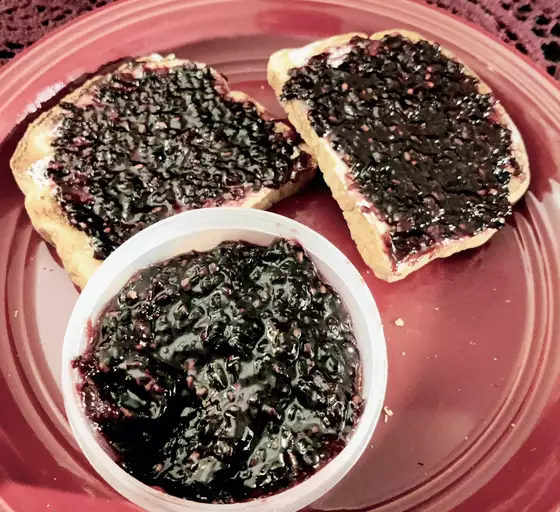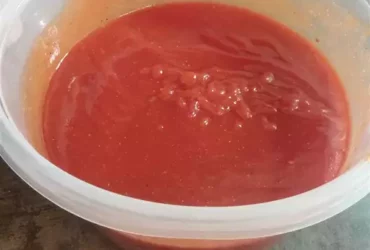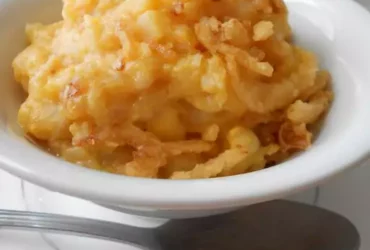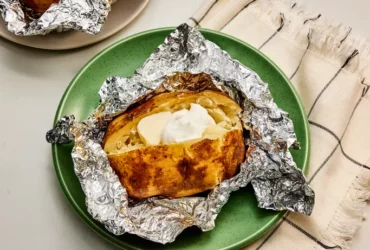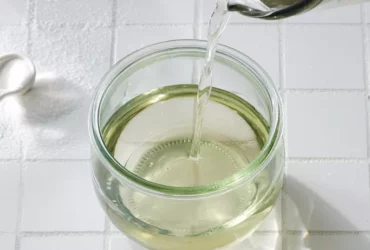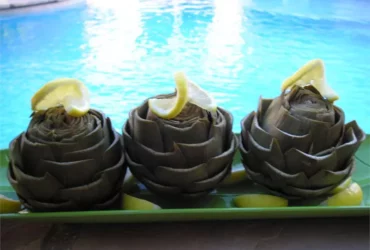Ingredients
Making of jam requires fresh or frozen fruit that is high in pectin.
Pectin is a natural gelling agent found in the cell walls of fruits, particularly in those that are high in acidity and have a high water content. For making jam, you need to use fresh or frozen fruit that is rich in pectin, which helps thicken the mixture and give it a smooth consistency.
Some common fruits that are high in pectin include citrus fruits like oranges and lemons, apples, berries such as blackberries, blueberries, and raspberries, and stone fruits like apricots and plums. When choosing fresh or frozen fruit for making jam, look for varieties that are heavy with juice and have a vibrant color.
For the Blackberry Jam Recipe, you will need to use a combination of fresh or frozen blackberries and other ingredients such as sugar, water, lemon juice, and pectin. The type of pectin used in jam making can be either natural or commercial, with the latter being more widely available in most supermarkets.
Commercial pectin is usually made from citrus fruits and comes in a powdered or liquid form that dissolves easily in water. Natural pectin, on the other hand, can be extracted from fruit peels, leaves, and seeds, but it requires more time and effort to prepare.
To determine whether your fruit is high in pectin, you can perform a simple test by mixing a small amount of fruit puree with sugar and water. If the mixture thickens quickly and forms a gel-like consistency, then it’s likely that your fruit contains sufficient amounts of natural pectin.
In the case of blackberries, which are commonly used in jam making, they contain a significant amount of natural pectin. However, if you’re using frozen blackberries or a combination of berries with lower pectin content, you may need to add commercial pectin to help achieve the desired consistency.
When selecting fresh or frozen fruit for jam making, it’s essential to choose varieties that are rich in natural pectin. By doing so, you’ll be able to create a homemade Blackberry Jam Recipe that’s not only delicious but also packed with nutrients and antioxidants from the high-quality fruit used in its production.
Berries, citrus fruits like orange and lemon, and apples are good sources of natural pectin.
- Pectin is a naturally occurring carbohydrate found in the cell walls of fruits, particularly those that are high in fiber and water content.
- The most common sources of natural pectin include berries such as blackberries, blueberries, raspberries, and strawberries.
- Citrus fruits like oranges, lemons, limes, and grapefruits also contain a significant amount of pectin, although it’s not as readily available in these types of fruit.
- Apples are another excellent source of natural pectin, making them an ideal choice for homemade jams and jellies.
- The reason why berries, citrus fruits, and apples are good sources of natural pectin is due to the high water content and fiber levels in these fruits.
- When these fruits are cooked down or crushed, the heat breaks down the cell walls, releasing the pectin into a liquid form that can be easily mixed with sugar and other ingredients to create a jam-like consistency.
- The resulting jam is not only delicious but also contains all the natural goodness of the original fruit, without any added preservatives or artificial flavorings.
- When making blackberry jam using natural pectin, it’s essential to use a combination of ripe and unripe blackberries to achieve the right balance of pectin levels.
- A mix of 75% ripe berries and 25% unripe berries will provide the perfect balance of sweetness and pectin content for an excellent homemade jam.
Preparation and Cooking
Cook the fruit with water and sugar until it reaches the gel point.
Cooking jam at home can be a fun and rewarding process, especially when making a classic blackberry jam recipe. To prepare for cooking, first wash and prepare the ingredients. Rinse 2 cups of fresh or frozen blackberries in cold water to remove any dirt or debris, then pat them dry with paper towels.
Next, combine the blackberries with 1 cup of granulated sugar and a splash of lemon juice in a large saucepan. The lemon juice will help to balance out the sweetness of the blackberries and preserve the color and flavor of the jam. Stir the mixture until the berries start to break down and release their juices.
Now, it’s time to cook the fruit mixture with water and sugar until it reaches the gel point. To do this, add 1 cup of water to the saucepan and bring the mixture to a boil over medium-high heat. Once boiling, reduce the heat to medium-low and let the jam simmer for about 20-25 minutes, or until it has thickened to your liking.
During the cooking process, occasionally stir the jam with a wooden spoon to prevent scorching and promote even cooking. You’ll know that the jam is almost ready when it starts to thicken and form a gel-like texture. To check for doneness, place a small amount of the jam on a chilled plate or spoon – if it holds its shape and doesn’t run, it’s ready.
Once the jam has reached the gel point, remove it from heat and let it cool slightly before transferring it to an airtight container. You can now store your homemade blackberry jam in the fridge for up to 6 months or in the freezer for up to a year. Enjoy!
The gel point is a critical temperature range (around 217-220°C) at which pectin molecules form a network that traps liquid and creates a jam-like consistency.
To prepare and cook blackberry jam, it’s essential to understand the concept of gel point and how it affects the final product. The gel point is a critical temperature range (around 217-220°C) at which pectin molecules form a network that traps liquid and creates a jam-like consistency.
Understanding Pectin and Gel Point
Pectin is a natural occurring substance found in the cell walls of fruits, particularly in the skin and core. It’s responsible for the gelation process that occurs when cooking jams and jellies. The gel point is crucial because it determines whether your jam will set properly or not.
Preparing Your Ingredients
To make blackberry jam, you’ll need the following ingredients:
- 2 cups of fresh or frozen blackberries
- 1 cup of granulated sugar
- 1 tablespoon of lemon juice
- 1 package of pectin (optional)
Note that if you’re using frozen blackberries, make sure to thaw them first and pat dry with a paper towel to remove excess moisture.
Cooking the Jam
To cook your jam, follow these steps:
- Combine the blackberries, sugar, and lemon juice in a medium saucepan. Heat the mixture over medium heat, stirring occasionally.
- Bring the mixture to a boil, then reduce the heat to medium-low and simmer for about 10-15 minutes, or until the fruit starts to break down and release its juices.
- Add the pectin (if using) and continue to cook for another 5-10 minutes, or until the jam has thickened and passed the “sheeting test”.
- Remove the saucepan from the heat and let it cool slightly. Use an immersion blender or a regular blender to puree the jam to your desired consistency.
- Return the saucepan to medium heat and cook for an additional 5-10 minutes, or until the jam has reached the gel point (around 217-220°C).
Now that you’ve cooked your jam to perfection, it’s time to let it cool and set. Pour the jam into sterilized jars and seal them immediately.
Tips and Variations
To get the most out of your blackberry jam recipe, keep the following tips in mind:
- Use fresh blackberries for the best flavor and texture.
- Don’t overcook your jam, as it can become too thick and sticky.
- Experiment with different spices and flavors to create unique variations of your blackberry jam recipe.
- Consider using a candy thermometer to ensure you’ve reached the gel point correctly.
By following these steps and tips, you’ll be well on your way to making delicious homemade blackberry jam that’s perfect for topping toast, yogurt, or using as a filling for cakes and pastries.
Packing and Storage
Transfer the cooked jam into sterilized jars and seal them tightly.
Packing and Storage for Homemade Blackberry Jam
After transferring the cooked jam into sterilized jars, it’s essential to seal them tightly to ensure that they remain fresh and free from contamination.
To store your homemade blackberry jam, follow these steps:
Sealing the Jars
- Wash the lids and rings in hot soapy water, then dry thoroughly with a clean towel or let air dry.
- Place the sterilized lids onto the jars, making sure they are securely seated on top of the jam.
- Add the sterilized rings to the jars, tightening them until just finger-tight.
- Use a canning funnel to minimize spills and make it easier to fill the jars.
Storage Options
- Store the sealed jars in a cool, dry place, such as a pantry or cupboard.
- Keep the jars away from direct sunlight, moisture, and heat sources.
- Avoid storing the jam near strong-smelling foods, as it may absorb odors.
Long-Term Storage
If you plan to store the blackberry jam for an extended period (more than 6 months), consider using a vacuum sealer or dehydrator to remove any air pockets and prevent spoilage.
Store the jars in airtight containers, such as glass or plastic bins with tight-fitting lids.
Before consuming your homemade blackberry jam, always check for signs of spoilage, such as off smells, mold, or an unusual texture. If you notice any of these signs, it’s best to err on the side of caution and discard the jam.
The jam can be stored in the fridge for up to 12 months, while frozen storage is possible for longer periods.
Packing and storing blackberry jam requires attention to detail to preserve its flavor and texture over time. When it comes to packing, use clean and sterilized containers that are specifically designed for preserving jams and jellies. This will help prevent contamination and spoilage. The container should be filled with the prepared blackberry jam, leaving about 1/4 inch of space at the top to allow for expansion during freezing or refrigeration.
The jam can be stored in the fridge for up to 12 months, as mentioned earlier. To store it in the fridge, place the containers in a single layer on a shelf and keep them away from direct sunlight and heat sources. Make sure the container is tightly sealed with a lid or airtight closure to prevent contamination.
For longer periods of storage, frozen storage is an option. Freezing preserves the flavor and texture of the jam by halting the growth of bacteria and mold. To freeze the jam, place the containers in the freezer at 0°F (-18°C) or below within a few hours of preparation. Frozen jam can be stored for up to 2 years without significant loss of quality.
When freezing, make sure to label the container with its contents, date, and any relevant storage instructions. This will help you keep track of how long it has been in the freezer and prevent confusion about what’s inside each container.
Before consuming the jam after storage, always check for signs of spoilage such as mold, sliminess, or an off smell. If the jam appears to be spoiled, discard it immediately and prepare a fresh batch.
When it comes to storing blackberry jam in bulk, consider dividing it into smaller containers or jars before freezing to make it easier to thaw and use what you need without having to defrost the entire batch.
Avoid cross-contamination by using separate equipment and utensils for packing and storing blackberry jam compared to other foods. This will help prevent the spread of bacteria and maintain the quality of your jam.
- Best Clay Alternatives for 2025 - April 22, 2025
- Best Leadfeeder Alternatives for 2025 - April 22, 2025
- Best Snov.io Alternatives for 2025 - April 21, 2025

